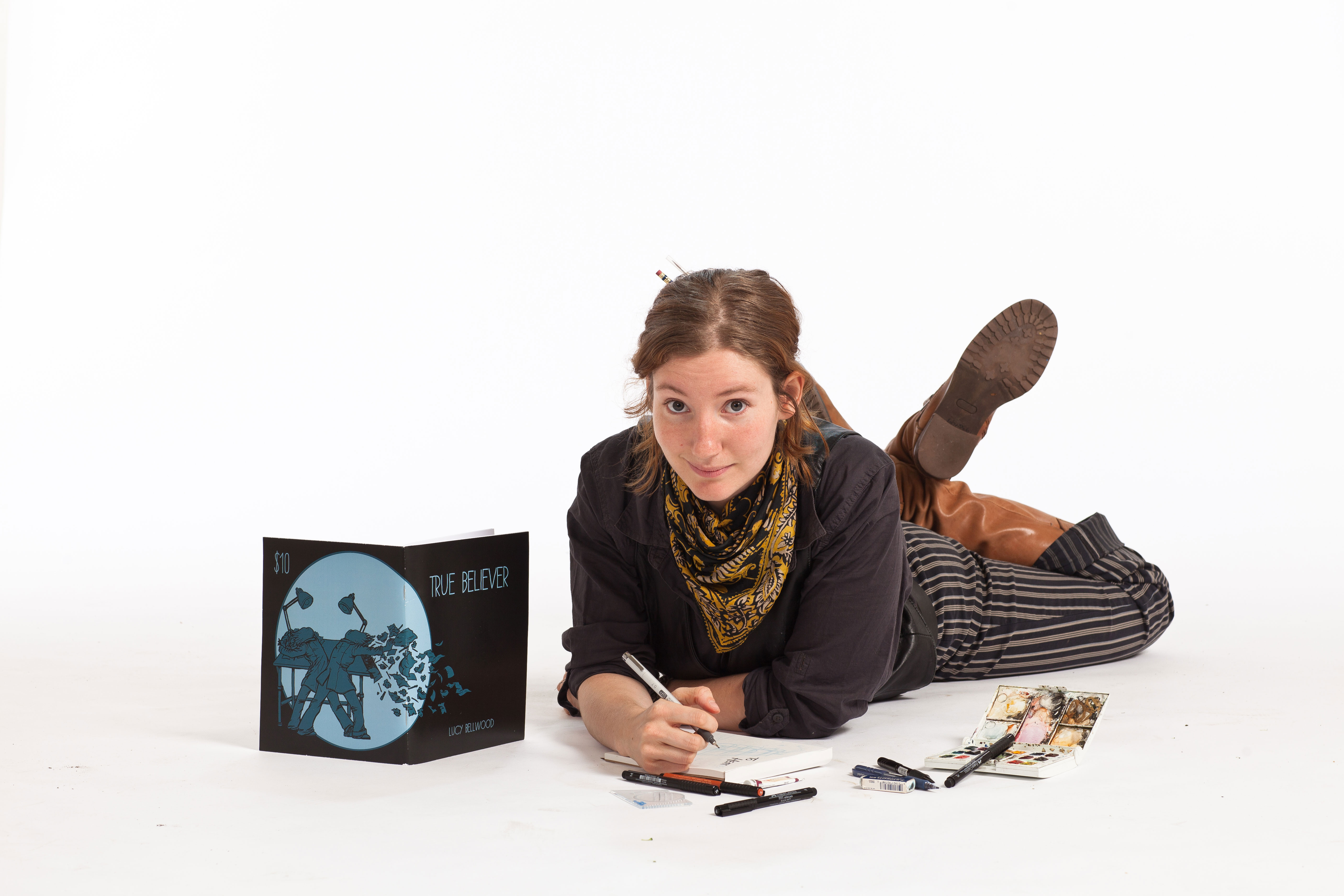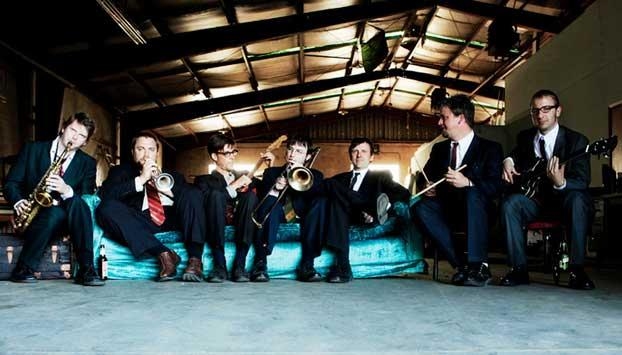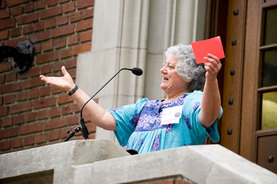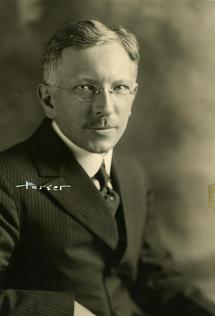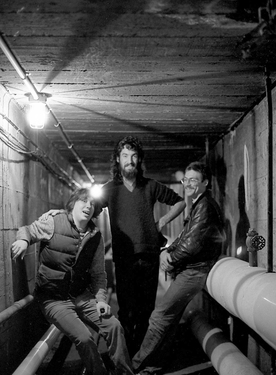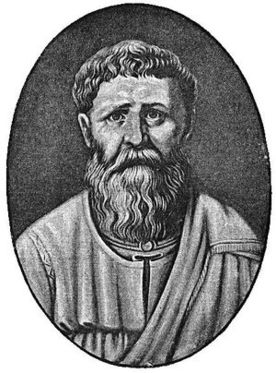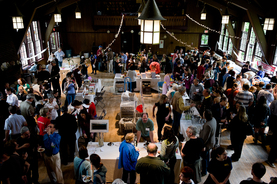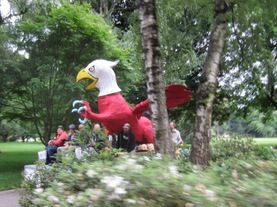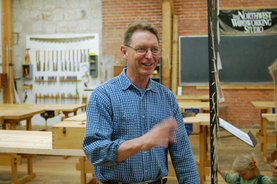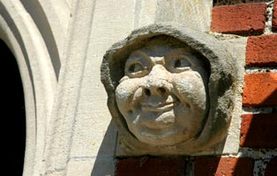
IRIS login | Reed College home Volume 96, No. 2: June 2017
Tags
"reunions"
Defining Your Own Career
Saturday of Reunions 2017,
Continue reading Defining Your Own Career
Westwind’s Whisper Echoes Still
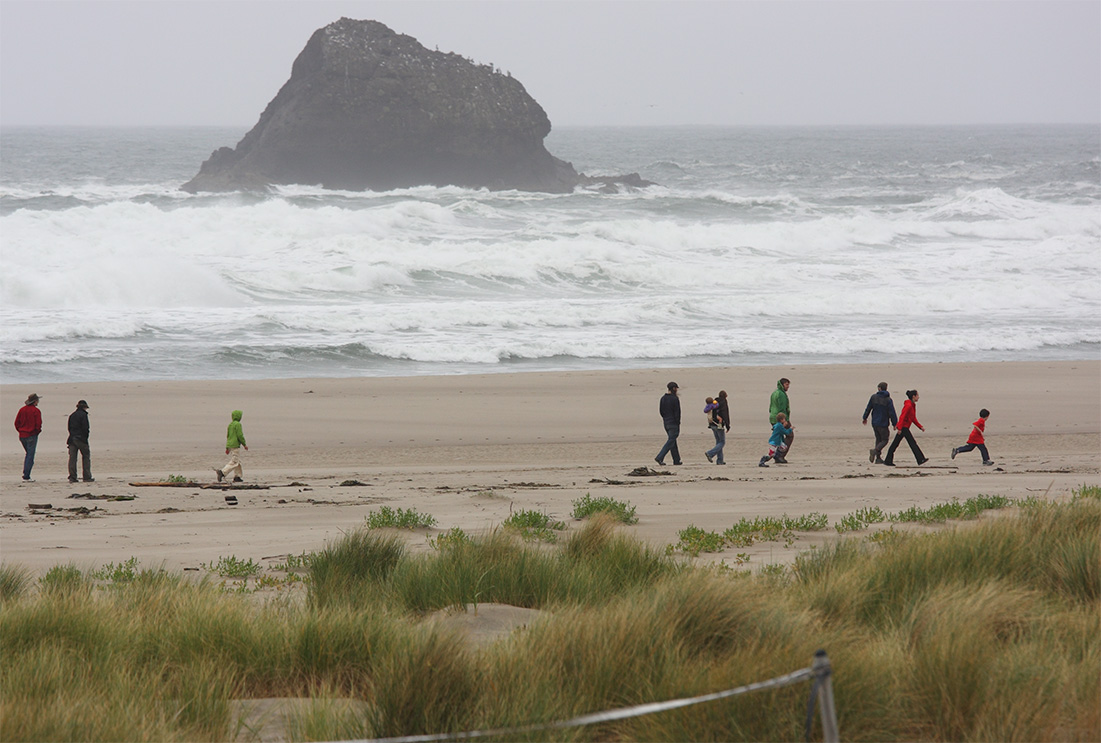
Alumni and their children comb the beach on the annual retreat at Camp Westwind. Photo by William Aegerter '85
Reedies gathered Saturday afternoon of Reunions 2017 to reminisce about Camp Westwind, the legendary annual retreat on the Oregon coast.
The session, led by Jim Quinn ’83 and Johanna Colgrove ’92, kicked off with a slideshow of the surf, cliffs, caves, and sunsets of the secluded camp.
As attendees treated themselves to cardamom pound cake—from a recipe that Johanna retrieved on Facebook from a former Paradox baker—Jim gave a history of Camp Westwind, starting with the collision of the North American and Juan de Fuca plates 50 million years ago. The camp itself, which was built by the YWCA in 1936, first hosted
Continue reading Westwind’s Whisper Echoes Still
The Taste of Reed

HOLY CRÊPE. Jehnee Rains ’93 of Suzette Crêperie whips up a culinary delight at Marketplace during Reunions 2016.
A bevy of Reedie entrepreneurs crowded the stately atrium of the Performing Arts Building on Saturday afternoon for Marketplace, the annual festival held at Reunions where alumni sample classmates' creativity in the culinary, mixological, and intellectual realms.
Carol Fredrick ’83, co-owner of Stone Griffon Vineyard in Carlton, offered tastes of four wines, from a refreshingly dry pinot noir blush to an estate-grown tempranillo. “People think of tempranillo as a warm-weather grape,” Fredrick explained, “but it’s actually grown in coastal regions of Spain, so it can do well in the Willamette Valley.”
Across the room, Minott Kerr ’80 of Clear Creek Distillery had set up shop. Dating to 1985, the Reedie-founded craft distillery is the second-oldest in the country, and that experience shines through in their huge lineup of award-winning, mostly fruit-based spirits. On Saturday, Kerr poured samples of their signature pear brandy—unaged, dry, but exploding with Bartlett pear flavor—as well as an oak-aged apple brandy and an intensely fruity loganberry liqueur. And then there’s the abiding mystery—however do they fit the pears into the bottles?
Continue reading The Taste of Reed
Reunions ’15 Opens with Fanfayre

Cheered on by Reunions attendees, retiring professors and staff were inducted into the ranks of honorary alumni. Photo by Leah Nash
More than 1,500 Reed alumni and allied life forms descended on campus last weekend for Reunions ’15, and the celebration began with Fanfayre, the formal-informal opening ceremony that took place this year in the Cerf amphitheatre.
The event began with a charmingly odd welcome by musician Paul Anderson ’92, the composer of Reed classics such as “Sensitive Guy” and “On the Night Bus.”
Paul’s offbeat presentation set the tone for the afternoon: President John Kroger made quips about Reed lacking a football team, raising a rousing cheer from the audience, while Scott Foster ’77, the outgoing president of the alumni board, assured the crowd that his cowboy hat he sported was legitimate because he does in fact own livestock.
Continue reading Reunions ’15 Opens with Fanfayre
Marketplace Spices Up Reunions 2014: Reedfayre
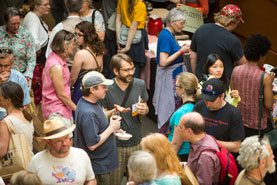
Hungry alumni swarm Marketplace at Reunions to taste creations of the culinary, mixological, and intellectual variety. Leah Nash
On Saturday afternoon of Reedfayre, the Performing Arts Building was abuzz with alumni, students, and families browsing the crafts, comics, cosmetics, and, most numerous of all, culinary creations, all cooked up by Reed alumni.
Always ready for a grand appearance, the Meat Smoke Crew greeted guests with enough pulled pork and brisket sandwiches to choke a Doyle Owl. Gigantic Brewing offered samples of its latest seasonal beers, including the Firebird smoked Hefeweizen, which founder Van Havig ’92 described as “like a peanut butter cup . . . two great things making one amazing thing.” Next door, Daniel Thomas ’89 served up delicious red and green tamales from his popular Portland restaurant Xico.
One of the most arresting displays belonged to Bob Combs ’90 of Combs Honey, whose table featured a transparent container filled with honeycomb—and live bees. Once drawn in by the bees, I couldn’t help but sample his blackberry honey and take home a couple slabs of honeycomb for myself.
Continue reading Marketplace Spices Up Reunions 2014: Reedfayre
Fanfayre Jumpstarts Reunions 2014

Andy McLain ’92 (left) receives the Babson Award from Greg Byshenk ’89 on behalf of Meat Smoke Crew. Photo by Leah Nash
Reed alumni spanning five decades descended on Cerf amphitheatre last week for Fanfayre Friday, the start of weekend festivities for Reunions '14: Reedfayre, June 4-8. The mood was festive (possibly more than usual because the signature cocktail known as Plato’s Punch swirled among the celebrants). Greg Byshenk ’89, president of the alumni board of directors, took the microphone and bid people find their seats. From the start, he set the theme of Fanfayre as one of gratitude, thanking the volunteers and class leaders who had come together to organize Reunions.
Comedian Yoram Bauman ’95 was introduced as "the world’s first stand-up economist" and the author of the newly published The Cartoon Introduction to Climate Change. Bauman launched into a polished comedy routine where he divided the crowd into various parts of the political spectrum and proceeded to rib the right and the left in turn. He poked at the Tea Party as people who “believe in social darwinism but don’t believe in Darwin,” but refused to make fun of the Occupy movement because “you are not allowed to make fun of the dead.”
The Babson Society Outstanding Volunteer Award was presented to Reed's own Meat Smoke Crew, the alumni group that has been hosting Renn Fayre feasts since 1985. Accepting the award on behalf of the crew, Andy McLain ’92 extoled the value of alumni-student interaction. Meat Smoke, he said, offered students the “comfort of a warm fire and the likelihood of a warm morsel.” Based on his experience, he reassured alumni that Reed students have not changed. “The kids are alright, I promise,” he said.
Continue reading Fanfayre Jumpstarts Reunions 2014
Savoring the Taste of Reed
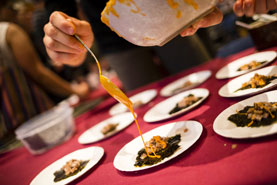
Minced pig trotters served on seaweed with a pepper aioli, offered a provocative mix of sweet and spicy. Photo by Leah Nash
Fresh bread, sweet honey, and a crisp wine to wash to all down. It’s not heaven, but it may be the next best thing: Gastronomy Northwest, the annual festival of food and drink produced by and for alumni, was held on Saturday afternoon of Reunions ’13: Reedfayre.
Making a piquant comeback from last year were David Autrey ’89 and his partner Amy Wesselman ’91 of the Westrey Wine Company, who served a delicate 2012 pinot gris and a refreshing 2010 pinot noir (you may have heard of their rising-star sons?). Also returning was the Clear Creek Distillery, operated by master distiller Steve McCarthy ’66 and his wife, artist Lucinda Parker McCarthy ’66. The Portland distillery employs mostly Reedies and specializes in brandies and liqueurs created from the fruit grown in the family’s orchards at the foot of Mount Hood. Their summery loganberry liqueur accented the natural tartness of the berry while perfectly satisfying the sweet tooth.
Continue reading Savoring the Taste of Reed
Fanfayre ’13 Looks Back, Looks Ahead
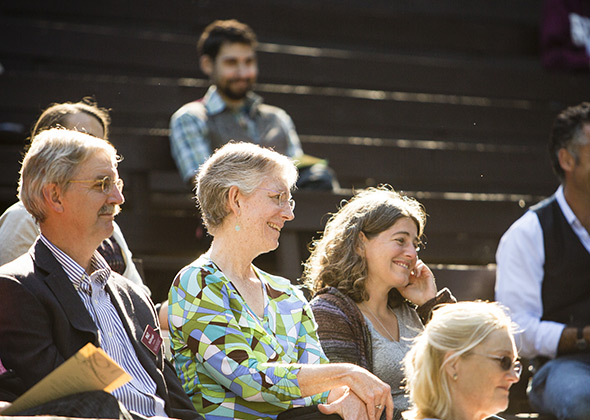
Retiring profs, including (left) Pat McDougal [chemistry] and (next to him) Ellen Stauder [English] were honored at Fanfayre ’13. Photo by Leah Nash
Like Janus, the two-faced Roman god of beginnings and transitions, Reunions '13: Fanfayre looked back to the past and forward to the college’s future in its recognition of distinguished alumni and faculty.
The keynote speaker was Eduardo Ochoa ’73, former Assistant Secretary for Postsecondary Education and current president of California State University, Monterey Bay. Eduardo, who also holds degrees in economics and nuclear engineering, analyzed the strengths, weaknesses, opportunities, and threats facing liberal arts colleges. He emphasized first the rapid pace of social change and the pressing need for a better-educated workforce in every sector of the economy. However, the rising cost of tuition poses a huge threat. “Only two percent of the population attend liberal art institutions,” he remarked. Liberal art colleges with a strong reputation and sound financial position (such as Reed) can still draw the best students, which represents an opportunity, especially since these students can become future leaders. “Reed has to focus on their leadership development because God knows we need it, after what I’ve seen in Washington,” he said.
Continue reading Fanfayre ’13 Looks Back, Looks Ahead
Kant, Reed, and the Aesthetics of Stools
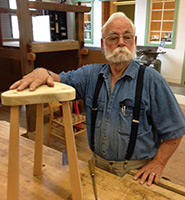 One of the highlights of Reunions '13: Reedfayre was Alumni College, a multi-disciplinary series of conversations and outings for Reedies of all ages. Aesthetics was the theme of this year's Alumni College #2 (which took place after Reedfayre), and school opened bright and early on Monday morning with a conference on Immanuel Kant’s Critique of Judgment (1790), led by Jan Mieszkowski [German 1997–].
One of the highlights of Reunions '13: Reedfayre was Alumni College, a multi-disciplinary series of conversations and outings for Reedies of all ages. Aesthetics was the theme of this year's Alumni College #2 (which took place after Reedfayre), and school opened bright and early on Monday morning with a conference on Immanuel Kant’s Critique of Judgment (1790), led by Jan Mieszkowski [German 1997–].
Mieszkowski started the conference with a question that is central to Kantian aesthetics: what does it mean to say that an object is beautiful? Naturally the gathered Reedies—including Harry Travis ’69, Lowell Weitkamp ’58, Carole Maxwell Stuart ’63, Monica Mayper ’73, and Chilton Gregory ’60—turned to the objects at hand: the stools they had built by hand under the tutelage of master woodworker Gary Rogowski ’72 the previous day. The group agreed that Chilton’s stool was particularly attractive, but Kant’s claim that a true aesthetic judgment was devoid of all interest provoked skepticism in some of the conference participants. Evolutionary biology, the Russian painter Wassily Kandinsky, and rose gardening were topics in the fiery debate on beauty and genius that followed.
In the afternoon the debate over aesthetics carried over to the kitchen, where the James-Beard-award-winning chef Diane Morgan ’77 took the same group of scholars through a series of recipes. Other sessions included:
Continue reading Kant, Reed, and the Aesthetics of Stools
Getting Funky at Reunions
Saturday night at Reunions '13: Reedfayre, June 12-16, doesn’t begin with the fireworks. This year, it starts with Tezeta Band, Portland’s premier Ethiopian-style rock band. Tezeta Band is a sort of reunion in itself: the band is composed of members of the Five Fingers of Funk, the hip-hop funk fusion band that rocked Portland in the 1990s.
Formed in 1992, with a career that spanned nearly 10 years, Five Fingers was the Pacific Northwest’s premier hip-hop experience, opening for the likes of De La Soul, The Roots, and Run DMC. Five Fingers wound down in the early oughts, with frontman-rapper Pete Miser leaving Portland for Brooklyn. The rest of the band stayed in the Rose City, however, and, after a few years pursuing their own projects, came back together in 2006 to explore new sonic territory: Ethiopia. For the last seven years the band has jammed on the unique fusion of jazz, rock, soul, and traditional African that defined Ethiopian music during its golden era of the 1960s and ’70s (captured in the wonderful album series Éthiopiques). Tezeta will be bringing all their influences on Saturday evening, so whether you’re a hip-hop head or a funk connoisseur, come on down to the SU and be prepared to boogie.
Continue reading Getting Funky at Reunions
Fanfayre honors history and achievement
Reunions 2012 traveled backward and forward through time at the Fanfayre ceremony celebrating outstanding alumni, staff, and faculty.
John Sheehy '82 presented his the epic oral history of Reed College, Comrades of the Quest, an volume of "almost biblical" dimensions that was, he said, the closest thing Reed has to scripture. Despite its size, he noted that the "director's cut" would be about 30-percent longer: "Reedies appear almost incapable of expressing themselves in a single sentence when a full paragraph—or a full dissertation—will do just as well."
Continue reading Fanfayre honors history and achievement
A Five-Octave Finale
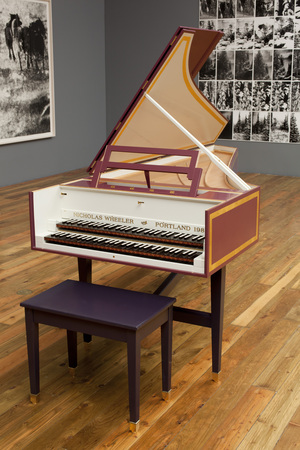 The Douglas F. Cooley Memorial Art Gallery was packed to the rafters last week as alumni from many eras came together in a hush of anticipation to witness a unique occasion--the unveiling of the French double harpsichord created by professor Nicholas Wheeler '55 [physics 1963-2010] over a span of 26 years, and showcased during Reunions '12: Reedfayre.
The Douglas F. Cooley Memorial Art Gallery was packed to the rafters last week as alumni from many eras came together in a hush of anticipation to witness a unique occasion--the unveiling of the French double harpsichord created by professor Nicholas Wheeler '55 [physics 1963-2010] over a span of 26 years, and showcased during Reunions '12: Reedfayre.
Nick became fascinated by the harpsichord (the distinguished ancestor of the piano) while playing at a concert his freshman year at Reed and resolved to build his own some day. He finally began work many years later, in August 1985, when he was A.A Knowlton Professor of Physics. While the bulk of the carpentry and metalwork were completed in the two years that followed, the venture languished for two decades when his teaching and other things took greater precedence. Nick was not able to put finishing touches on the instrument until after his retirement in 2010, after 47 years of service.
"This is a Reed instrument and its first public appearance. It's something I've fantasized about for 60 years," Nick remarked. Returning students and friends continued to ask over the years when and if the project would ever be finished. "It is a doubt which I confess, I sometimes shared: it gave me anxiety because I did not want to leave to my heirs the problem of figuring out how to dispose of a stringless box that looked like a harpsichord, but was unplayable." However friends, such as professor Kathleen Worley, [theatre 1985-] helped along the way by picking up some gold-dipped hardware and wood scrapers.
Continue reading A Five-Octave Finale
Paradox Embraced: A History of Reed Presidents
Reed's presidential history, like that of the college itself, is a history of paradoxes.
This was the argument of trustee and historian John Sheehy '82 in his lecture "The Presidents of Reed" at Reunions 2012. The central paradox of Reed, he said, is the combination of academic conservatism with cultural progressivism. This has given birth over the years to such quandaries as Reed's historically high attrition rate (as students struggled to impose the self-discipline required for intellectual freedom) to ongoing debates like faculty pay equity or marijuana use on campus.
These conflicts, though, have by no means held Reed back. Instead, Sheehy said, "the only way to move forward was to work within the paradoxes." The Honor Principle was one example of this, occupying the "middle ground" between rules and anarchy. In the end, it has been how well each president has embraced the Reed paradox that has determined his success.
Continue reading Paradox Embraced: A History of Reed Presidents
Sweating It out in the Steam Tunnels
Dimly lit pathways, dusty pipes, graffiti, and intense humidity. At Reed, that could mean one place on campus—the steam tunnels.
One of the attractions during Reunions: Reedfayre '12 was a tour of Reed's mysterious steam tunnels by the Physical Plant's own Steve Yeadon. The labyrinthine route, which made one feel like Indiana Jones on a dangerous mission, started from the basement of Physical Plant, where two gigantic boilers (usually fired by gas, but sometimes by oil, if gas is too expensive) generate the steam that gives the tunnels their purpose.
The tour then wound its way through the depths of Reed, as visitors took care not to bump into the cobwebbed walls or pipes. The abundant graffiti on the pipes, preserved through the years (because as one alum mentioned, the pipes were the only things not whitewashed over for commencement every year), proved highly entertaining.
Continue reading Sweating It out in the Steam Tunnels
Laughing without Lips: the Last Lecture
The final Hum 110 lecture of the year is one of Reed's longstanding rites of passage. After eight long months of Homer, Plato, and Sophocles, freshlings often feel a little rowdy—and the fact that the lecture typically takes place on the Friday of Renn Fayre only amplifies the sense of mischief. (One year several students actually removed their clothes during the lecture.)
In 2003, professor Jan Mieszkowski [German 1997–] volunteered to give the last lecture on St. Augustine's Confessions, a duty he reprised until 2011 when the syllabus was revised. (St. Augustine may belong to the ages, but he no longer belongs to Hum 110.)
Professor Mieszkowski delivered the lecture, by turns provocative, funny, and profound, at Reunions 2012 to an audience of appreciative alumni.
Continue reading Laughing without Lips: the Last Lecture
Grazing at Gastronomy Northwest
By Angie Jabine '79
Vegetarian banh mi, ice-brewed coffee, salted watermelon, and a luscious Imperial Black Saison beer were just a few of the delicacies that drew throngs of alumni to Gastronomy Northwest at Reedfayre '12. For two hours, the student union was packed solid with Reedies vying for sips and samples, while taking care not to tread on various toddlers underfoot.
Continue reading Grazing at Gastronomy Northwest
Griffin to Make Triumphant Return to Rose Parade
After more than 75 years' absence, a Reed College float will once again join the Portland Rose Festival's Grand Floral Parade, taking place this Saturday, June 9.
Reed first entered a float into the Rose Parade in 1936; although Reedies have played many important roles in the festival since, our beloved institution has never again been represented by its own float.
Continue reading Griffin to Make Triumphant Return to Rose Parade
The Magic Hand Plane
When people come to Gary Rogowski '72 with questions about making a living as a woodworker, he sets them straight.
"It's a terrible way to make a living," he says. "You want to drive a Porsche? Forget it. But it's a great way to live."
Throughout Reunions week, Gary led visiting alumni on tours of his studio in an elegant, old industrial building in Southeast Portland. Amidst the smells of wood, the scratch of sandpaper, and walls lined with hand drills, Japanese pull saws, and clamps, guests posed question about such things as wood pegs versus nails.
Continue reading The Magic Hand Plane
Defining Reed
It's been several weeks, but I'm still recovering from Reunions 2011 and its glorious aftermath. Quite apart from the epic rugby match, the spectacular musical performances, and the phenomenal chance encounters, I found myself pondering anew the question that President Colin Diver posed at his centennial address. Stripped to its elements, how do you define Reed?
To read Diver's speech, click here or watch the video.
Continue reading Defining Reed
Reed Takes Center Stage, Literally
By Ethan Knudson '11
Ten decades of Reed were celebrated at Centennial Reunions in one-act plays rife with academic jokes, historical references, and the tumultuous emotions that permeate a return to campus.
Reedies from several decades stepped on stage in the chapel to play stressed-out seniors, hesitant freshmen, and even legendary philosophy professor Marvin Levich. In one scene, merry prankster Ken Kesey wrestles Owen, the freshman from Idaho, at an early Renn Fayre.
Continue reading Reed Takes Center Stage, Literally

